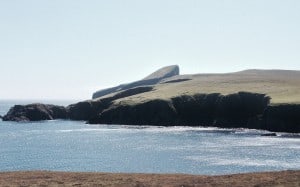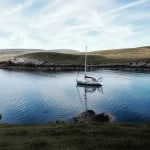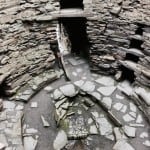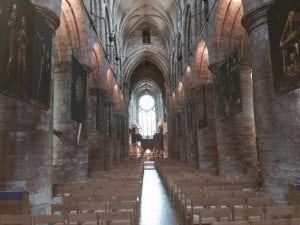On Sunday we had a gentle sail against the wind down the east coast of Shetland Mainland and came to the no-longer inhabited island of Mousa, which we had entirely to ourselves. We anchored in a bay and went ashore to visit the broch. Brochs are ancient round towers built some 2000 years ago and the one on Mousa is the finest and most intact of any, with exquisite stone work made possible by the abundant supply of thin stones on the island. The purpose of brochs is unclear, but they were probably defendable dwellings rather than forts. The towers have a double wall construction with stone ties between inner and outer wall, making them strong for their weight – think cavity walls with a huge cavity. Low down we found rooms between the walls, some probably for storage but others with stone alcoves and presumably living or sleeping rooms. A stairway curving round between the walls leads to the top. The views were magnificent.
- Antipole at anchor off Mousa
- Mousa broch
- Inside the broch
- Broch stairway
Mousa is owned by the RSPB and is home to many interesting birds as well as grey and harbour seals. There were thousands of tiny Storm Petrels nesting on the rocky foreshore. As evening came we heard the remarkable deep churring sound they make from their burrows. We were buzzed by Arctic Terns and Arctic and Great Skuas, both warning us off their nests. The skuas are aggressive birds that live largely by robbing other birds of their food. They aggressively defend their nests by diving at intruders rather alarmingly, as we experienced. They are known here as Bonxies, presumably because they can bonk you on the head as you walk along. On Monday morning the mists had cleared to blue skies and we visited the broch again.
 Fair Isle people lead a pretty independent existence. They have their own ferry which travels to Shetland three times per week, weather permitting. We saw the ferry arrive and many islanders came to meet it to collect stuff awaited, such as stores for the shop. In the photo you can see in the distance a rock with a sloping grass-covered top. This rises steeply from the sea and we read it is regarded as unclimbable. But until 1977 islanders took small boat-loads of sheep out to the seaward side and hauled them up on ropes to graze the grassy top.
Fair Isle people lead a pretty independent existence. They have their own ferry which travels to Shetland three times per week, weather permitting. We saw the ferry arrive and many islanders came to meet it to collect stuff awaited, such as stores for the shop. In the photo you can see in the distance a rock with a sloping grass-covered top. This rises steeply from the sea and we read it is regarded as unclimbable. But until 1977 islanders took small boat-loads of sheep out to the seaward side and hauled them up on ropes to graze the grassy top. We had a lovely walk out to the North Lighthouse and watched Arctic Skuas and a puffin colony close up. In the photo you can see Ynskje carrying her walking stick above her head to deter the Bonxies from getting too close.
We had a lovely walk out to the North Lighthouse and watched Arctic Skuas and a puffin colony close up. In the photo you can see Ynskje carrying her walking stick above her head to deter the Bonxies from getting too close.Kirkwall is an interesting town with the long winding streets with alley ways off that we have seen in Stromness and Lerwick. It is a fine example of a Norse town layout. The magnificent St Magnus cathedral was founded in 1137. dominates the town and is absolutely stunning inside.






We are so enjoying your journey visiting such remote and interesting places. Love the blog. So glad you are having a good trip. We hope the winds are kind to as you head South.
Good sailing
Love
Nicky
Great to hear you made it to Fair Isle, somewhere that has always held a fascination for me. Love David
Love for both from Kroatie where we are camping with 4 women and 2 childeren. Keep follwing you